What is fruit fly?
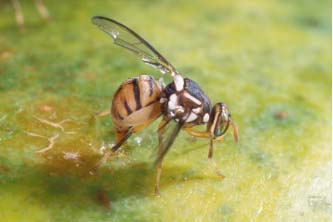
It is a flight insect and polyphagous in nature which makes it most destructive pest. In India 200 species of fruit fly has been recorded out of which 30-40 species of flies causes damage.
Life cycle of fruit fly
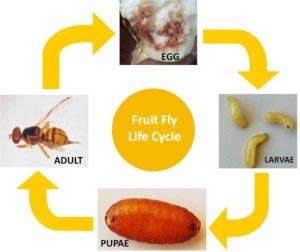
Egg – Female flies lay eggs under the skin of fruit in clusters of 10 -50 inside the fruit surface. The colour of eggs is white, elongated and elliptical and after laying eggs it usually hatches in 1-2 days.
Larva – The white larva is legless and resembles an elongated cone and mouth is present at the pointed end of body. The larva has 3 stages and it last long for 11-15 days.
Pupa – After completion of larva stage it will drop on the ground and pupate in the soil. The puparium is yellowish brown and seed like structure. Pupation last for around 10 days. This is the stage where it develops itself into adult fly.
Adult – Female begins to lay eggs about 8 days after the emergence from the pupation. It can lay more than 3000 eggs during her lifetime.
How fruit fly damages Dragon Fruit?
- The maggots feed on the fruit pulp causing the fruit to rot.
- Maggot bore into the semi ripened fruits and cause direct damage by puncturing the fruit skin to lay eggs.
- After fully development of maggots, it will emerge out by making hole for the pupation in soil.
Symptoms
- The first sign is a small puncture wound (scar)
- The infested fruit may become deforms and during heavy infestation the fruits usually drop off.
- The excreta of the larvae accumulate in the galleries causing fruit rot.
Prevailing month-
- Fruit flies are more active during September – February.
How to manage or control the fruit fly?
| Cultural Practices | Biological Control | Chemical Control |
| Clean cultivation and sanitation of orchard should be followed by picking and destroying the infested fruits.Collection of fallen infested fruits and dispose them by dumping in a pit and covering with soil.Tillage is an important operation in controlling the fruit fly. Manually raking the soil around the trees during summer season to expose the pupae to sunlight and other natural enemies can control the fruit fly. | Use of Verticillium leccani @ 5 ml per liter twice at fortnightly interval during flush season. | Pheromone Trap – Uses of Methyl eugenol sex lure traps |
Setting up Pheromone Traps
- Fruit fly being flight insects are difficult to control with regular insecticidal sprays therefore its recommended and advantageous to choose pheromone traps.
- Use of methyl eugenol pheromone traps is found to be effective in controlling this pest. These pheromone traps are also helpful in early detection of these pests and controlling its population.
- It is recommended to take 10 ml of this mixture per trap to setup 10 Pheromone traps in a plot size of 1 acre, where they are hanged at a height of 5 to 6 feet, well before the ripening of fruits. These pheromone traps needs to be replaced at weekly intervals.
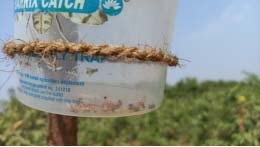 | 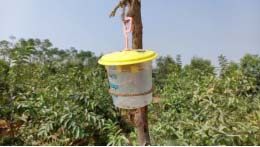 |
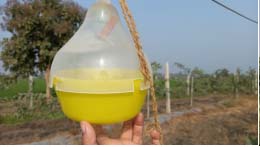 | 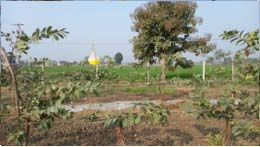 |
Placement of Pheromone Traps
These traps can be placed in site where fruit flies are mostly seen in the orchard. It can be hanged in tree trunks itself. The motive of this exercise is to cover major areas of the orchard.








